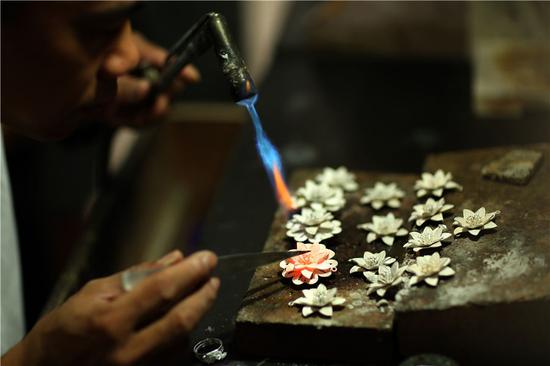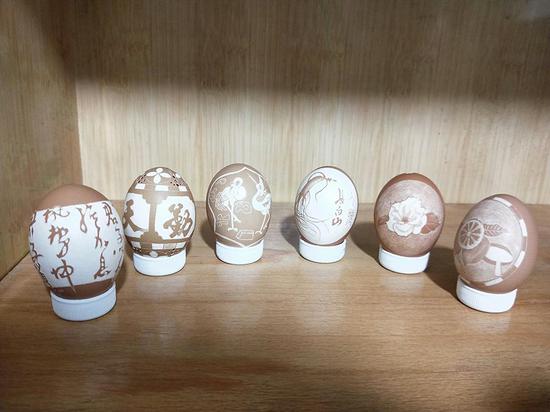
Qu Yunxiao was offered a job as a crawfish "taster" in Qianjiang, Hubei province, after she finished her studies in the UK. She has to eat 1 kilogram of crawfish each day and sometimes up to 5 kg. (Photo for China Daily/Niu Jing)
The market continues to expand rapidly.
Last year, Hubei Laker Group, a major crawfish processor with headquarters in Qianjiang, 150 kilometers west of Wuhan, produced 3,000 metric tons of head-chopped crawfish, one of the company's main products. This year, by June 23, the company had produced the same amount and production will continue for at least another two months, according to Xu Menglin, a company spokeswoman.
Orders for a total of 2,500 tons of fried crawfish, a new product launched this year by the company, have also been received. "Previously, dealers came only after production started in April. This year, however, many came much earlier to secure orders," Xu said.
The company began exporting crawfish in 2003 and has become a major supplier. Before 2014, it mainly served the international market and 90 percent of its products were for export.
However, as domestic demand continued to grow, 60 percent of the company's crawfish products now go to Chinese diners, Xu said, adding that Hubei Laker Group now has agencies in all provincial regions of the Chinese mainland apart from the Tibet autonomous region.
In the 1990s, Liu Zhuquan, a farmer in Qianjiang, reportedly invented an agricultural method to combine rice planting with crawfish breeding. This has been widely adopted in many areas of China and has helped to greatly increase the supply of crawfish.
Even Liu has been surprised by the popularity of crawfish. "The dish is so popular that many crawfish were put onto the market even before they grew mature this year," said the farmer, who has been in the industry since coming up with the new method.
According to the authorities in Qianjiang, Liu's method is now used in more than 43,000 hectares of rice fields in the city. The industry's production value reached 23 billion yuan last year.
Qianjiang, which has a population of about 1 million, now boasts more than 2,000 crawfish restaurants, which can offer more than 100 different courses of the dish. About 500,000 tons of crawfish are eaten in the city annually, and more than 150,000 people now work in crawfish-related industries.
So, why has crawfish become so popular in China?
Zhang Denghua, president of Chuxiawang, a crawfish restaurant in Qianjiang, said the dish has gained popularity as it "offers the best platform for people to socialize".
Nowadays, it is not unusual to see diners busy with their phones instead of chatting with each other when eating dinner together. If they eat crawfish, however, using their phones becomes difficult, even impossible, as they have to use their hands to pull off the shells, leaving their hands covered in oil.
The dish is tasty, but it takes a lot to satisfy diners. So they continue to eat, which also prevents them from holding their phones, Zhang said.
Chuxiawang now runs 68 chain outlets in southern China, including Hubei, Hunan and Zhejiang provinces. Zhang said the outlets' revenue had risen by more than 100 percent annually since 2013.
He did not disclose the total revenue, but said turnover at his 500-square-meter restaurant launched in April in Changsha, the capital of Hunan, was almost 80,000 yuan on June 22.
"Crawfish used to be only a midnight snack, but has become a formal dish for dinner," he said.
The increasing price of crawfish has failed to halt the rise in demand. "The price for crawfish with an average weight of more than 20 grams was more than 20 yuan a kilogram this time last year, but has rocketed to about 40 yuan. Demand still exceeds supply," Zhang Denghua said.
Zhang Jun, an engineer from Wuhan, has been eating crawfish since 2003. He said that originally the dish was only sold in small, dingy restaurants but is now served in more upmarket eateries.
Zhang Jun said crawfish works well in helping people to socialize, but he does not agree that it has gained in popularity because it prevents people from playing with their phones during dinner.
"No matter who you are and what your social status is, you have to pocket your pride when eating crawfish. You have to roll up your sleeves, as the oil will soon cover your hands and even flow to your elbow. From this point of view, everybody is equal to each other when eating the cuisine. It helps bridge the gap between different people," he said.
Zhang Jun said crawfish does not have much meat. It is time-consuming to eat, which makes it a perfect food for people to enjoy together.
Wuhan is located in central China. Although food in the city is not as delicate as that in regions to the south, it is not as simple as the food in regions to the north, he said, adding that the city's food is easily accepted by people nationwide.
He said the main reason for the popularity of crawfish is its taste, which appears to be universally accepted by all diners.
Li Fei, the man from Urumqi, said: "Instead of beer, we drank spirits. Why? Because beer takes up too much room in the stomach. The crawfish is tasty. We want to save space for it."
He then finished his dinner as dozens of people were still waiting outside the restaurant for tables.


















































